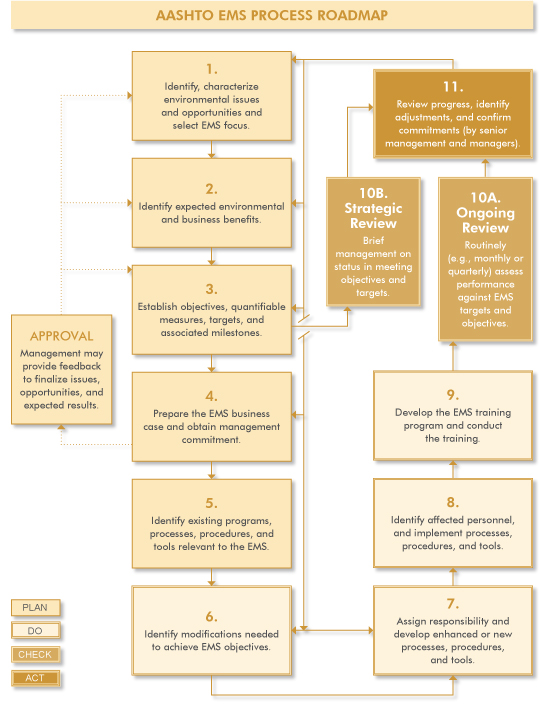Background
Transportation agencies are working to meet the expectations of citizens, elected officials, regulators and other stakeholders for transportation projects and programs that meet mobility needs while preserving and enhancing the environment. To meet these expectations, transportation agencies are:
-
- Demonstrating environmental stewardship in all facets of their day-to-day and long-term activities,
- Improving environmental and business performance, and
- Taking actions to ensure consistent compliance.
As a result, transportation agencies are making environmental stewardship a part of their mission, including all facets of their operations – from planning through routine maintenance. Environmental stewardship entails making decisions and conducting operations in a manner to protect and improve the environment.
Environmental performance expectations include waste minimization, pollution prevention, reducing resource consumption, and minimizing the environmental “footprint” of transportation facilities and projects. In short, transportation agencies must spend less time and money while fulfilling all stakeholder environmental expectations.
Stewardship and performance begin with and are based upon actions to ensure that a transportation agency consistently complies with applicable environmental requirements. Inconsistent compliance, in fact, jeopardizes the respect and response that transportation agencies gain from other noteworthy environmental initiatives and efforts.
Successful fulfillment of these expectations requires a comprehensive, integrated, systematic approach that involves employees at all levels and across all functions in a transportation agency, from planning and design, through construction, operation, and maintenance. An environmental management system (EMS) offers an approach to reach these goals.
AASHTO has defined EMS as it applies to transportation programs as follows: An EMS is the organizational structure and associated responsibilities and processes, procedures, and tools for integrating environmental considerations and objectives into the ongoing management decision-making processes and operations of an organization.
This definition has been developed to provide flexibility for transportation agencies to implement EMSs that meet their specific needs and objectives. This definition incorporates key elements of and is consistent with definitions contained in EPA’s Compliance Focused Environmental Management System (CFEMS) guidance and the International Standards Organization (ISO) 14001 Environmental Management System (EMS) standard. Information on the ISO 14001 EMS Standard is available on the ISO website or EPA’s EMS website.
EMSs have provided demonstrated, measurable environmental as well as business performance improvements for numerous Federal, state, and local governments and private sector companies throughout the United States over the last decade or more. Recognizing these benefits, several transportation agencies have developed and implemented EMSs to achieve similar enhancements in various transportation activities and facilities.
Additional details on developing and implementing an EMS in a transportation agency are summarized in AASHTO’s EMS Practitioner’s Handbook, Developing and Implementing an Environmental Management System in a State DOT.
Value to Transportation Agencies
EMSs have been shown to provide a variety of environmental and business performance benefits. Environmental benefits realized through EMSs in transportation agencies include:
-
- Reductions in the number, type, and severity of compliance incidents;
- Pollution and waste quantity reductions;
- Recovered resources; and
- Streamlined permit and document reviews and approvals.
Business performance improvements attained through these EMS initiatives include:
-
- Reduced regulatory oversight schedule and cost burdens,
- Faster project delivery and, in turn, labor savings through streamlined reviews and approvals,
- Improved relationships with external stakeholders,
- Increased workforce efficiency, and
- Cost savings and cost avoidances from the integration of environmental needs and opportunities into both long-range and day-to-day activities.
Additional information on EMS achievements in transportation agencies can be found in the AASHTO Standing Committee on Highways report Environmental Management Systems Implementation Update. This report found that 27 state transportation agencies either had implemented or were in the process of developing EMSs. This level of activity reinforces the growing awareness on the part of transportation agencies of the performance achievements available through an EMS.
Transportation Agency EMS Drivers
There are three basic factors that “drive” a transportation agency’s decision to move forward with an EMS. Following are brief descriptions of these three “drivers” – must, comply, or improve. In the case of must, EMS efforts respond to an enforcement mandate. In the instances of comply or improve, EMS efforts may be an initiative undertaken by a transportation agency or a response to legislative or gubernatorial directive.
-
- MUST. An EMS is required under a settlement agreement with a state regulatory agency and/or EPA. Over the last five years, several DOTs and other transportation agencies have been required to implement an EMS in a particular function or facility to address regulatory findings and notices.
- COMPLY. An EMS is used to ensure and demonstrate regulatory compliance. Several transportation agencies have implemented EMSs to ensure that they have the means to: conduct day-to-day activities and operate facilities in a compliant-manner, assess their conformance, and take actions to maintain compliance. In this instance, an EMS
- IMPROVE. An EMS is developed to continually improve environmental and business performance. Moving beyond simple compliance, transportation agencies have implemented EMSs that provide the means to integrate environmental performance improvement into day-to-day activities as well as their decision making processes.
While the rationale for implementing an EMS may vary, the applicability to transportation agencies is clear and demonstrated.
EMS Fundamentals
EMSs are based on the Plan-Do-Check-Act (PDCA) framework – a proven management system structure for continual improvement recognized by a wide range of institutions, including AASHTO, the U.S. Environmental Protection Agency (EPA), and the International Organization for Standardization EMS Standard (ISO 14001).
Additional details on EMS fundamentals and keys to success are presented in the AASHTO Handbook, Developing and Implementing an Environmental Management System in a State DOT.
EMS Roadmap
AASHTO has developed an EMS process roadmap tailored to the needs and constraints of transportation agencies. Details on using the AASHTO Roadmap to develop, implement, and maintain an EMS are presented in the AASHTO Handbook, Developing and Implementing an Environmental Management System in a State DOT. The AASHTO roadmap, presented below, incorporates key elements of the ISO 14001 EMS Standard and EPA’s Compliance Focused Environmental Management System (CFEMS) guidance.

